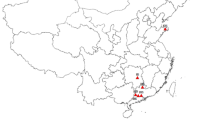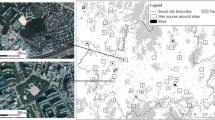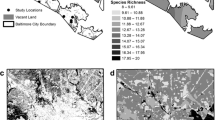Abstract
Roadless areas on public lands may serve as environmental baselines against which human-caused impacts on landscape structure can be measured. We examined landscape structure across a gradient of road densities, from no roads to heavily roaded, and across several spatial scales. Our study area was comprised of 46,000 ha on the Roosevelt National Forest in north-central Colorado. When forest stands were delineated on the basis of seral stage and covertype, no relationship was evident between average stand size and road density. Topography appeared to exert a greater influence on average stand size than did road density. There was a significant positive correlation between the fractal dimension of forest stands and road density across all scales. Early-seral stands existed in greater proportions adjacent to roads, suggesting that the effects of roads on landscape structure are somewhat localized. We also looked at changes in landscape structure when stand boundaries were delineated by roads in addition to covertype and seral stage. Overall, there was a large increase in small stands with simple shapes, concurrent with a decline in the number of stands > 100 ha. We conclude that attempts to quantify the departure from naturalness in roaded areas requires an understanding of the factors controlling the structure of unroaded landscapes, particularly where the influence of topography is great. Because roads in forested landscapes influence a variety of biotic and abiotic processes, we suggest that roads should be considered as an inherent component of landscape structure. Furthermore, plans involving both the routing of new roads and the closure of existing ones should be designed so as to optimize the structure of landscape mosaics, given a set of conservation goals.
Similar content being viewed by others
References
Adams, L.W. and Geis, A.D. 1983. Effects of roads on small mammals. Journal of Applied Ecology 20: 403–415.
Ales, R.F., Martin, A., Ortega, F. and Ales, E.E. 1992. Recent changes in landscape structure and function in a mediterranean region of SW Spain (1950–1984). Landscape Ecology 7: 3–18.
Baker, W.L. 1992. Effects of settlement and fire suppression on landscape structure. Ecology 73: 1879–1887.
Baker, W.L. 1993. Spatially heterogeneous multi-scale response of landscapes to fire suppression. Oikos 65: 66–71.
Bakowski, C. and Kozakiewicz, M. 1988. The effect of forest roads on bank vole and yellow-necked mouse populations. Acta Theriologica 33: 345–353.
Bennett, A. 1991. Roads, roadsides and wildlife conservation: a review.In Nature Conservation 2: The Role of Corridors, pp. 99–117. Edited by D.A. Saunders and R.J. Hobbs. Surrey Beatty & Sons, Chipping Norton.
Bider, J.R. 1968. Animal activity in uncontrolled terrestrial communities as determined by a sand transect technique. Ecological Monographs 38: 269–308.
Burnett, S.E. 1992. Effects of a rainforest road on movements of small mammals: mechanisms and implications. Wildlife Research 19: 95–104.
Buttery, R. and Gillam, B. 1987. Forested ecosystems,In Managing Forested Lands for Wildlife, pp. 43–71. Edited by R. Hoover and D. Wills. Colorado Division of Wildlife in cooperation with U.S. Department of Agriculture, Forest Service, Rocky Mountain Region, Denver, Colorado.
Chen, J., Franklin, J. and Spies, T. 1992. Vegetation responses to edge environments in old-growth Douglas-fir forests. Ecological Applications 2: 387–396.
Covington, W. and Moore, M. 1992. Postsettlement changes in natural fire regimes: implications for restoration of old-growth ponderosa pine forests.In Old-growth Forests in the Southwest and Rocky Mountain Region: Proceedings of a Workshop. General Technical Report RM-213. pp. 81–99. Edited by M. Kaufmann, W. Moir, an R. Bassett. Department of Agriculture, Forest Service, Rocky Mountain Forest and Range Experiment Station, Fort Collins, Colorado.
Daniel, W.W. 1990. Applied Nonparameter Statistics. Second Edition, PWS-Kent, Boston.
Erickson, K. and Smith, A. 1985. Atlas of Colorado. Colorado Associated University Press, Boulder.
ESRI. 1991. Arc/Info Users Guide. Environmental Systems Research Institute, Redlands, California.
Ferris, C.R. 1979. Effects of Interstate 95 on breeding birds in northern Maine. Journal of Wildlife Management 43: 421–427.
Forman, R. and Godron, M. 1986. Landscape Ecology. John Wiley & Sons, New York.
Foster, D.R. 1992. Land-use history (1730–1990) and vegetation dynamics in central New England, USA. Journal of Ecology 80: 753–772.
Franklin, J. 1993. Preserving biodiversity: species, ecosystems, or landscapes. Ecological Applications 3: 202–205.
Franklin, J. and Forman, R. 1987. Creating landscape patterns by forest cutting: ecological consequences and principles. Landscape Ecology 1: 5–18.
Harris, L. 1984. The Fragmented Forest. University of Chicago Press, Chicago.
Knight, D. 1987. Parasites, lightning, and the vegetation mosaic in wilderness landscapes.In Landscape Heterogeneity and Disturbance. pp. 59–83. Edited by M.G. Turner. Springer-Verlag, New York.
Krummel, J., Gardner, R., Sugihara, G., O'Neill, R. and Coleman, P. 1987. Landscape patterns in a disturbed environment. Oikos 48: 321–324.
Lagro, J.A. Jr. and DeGloria, S.D. 1992. Land use dynamics within an urbanizing non-metropolitan county in New York State (USA). Landscape Ecology 7: 275–289.
Lovejoy, S. 1982. Area-perimeter relation for rain and cloud areas. Science 216: 185–187.
Luque, S.S., Lathrop, R.G. and Bogner, J.A. 1994. Temporal and spatial changes in an area of the New Jersey Pine Barrens landscape. Landscape Ecology 9: 287–300.
Mandelbrot, B.B. 1977. Fractals: Form, Chance, and Dimension. W.H. Freeman and Company, San Francisco, California.
Marr, J.W. 1961. Ecosystems of the East Slope of the Front Range in Colorado. University of Colorado Studies Series in Biology 8.
McLellan, B. and Shackleton, D. 1988. Grizzly bears and resource-extraction industries: effects of roads on behaviour, habitat use and demography. Journal of Applied Ecology 25: 451–460.
Mielke, P.J. 1984. Meteorological applications of permutation techniques based on distance functions.In Handbook of Statistics, Vol. 4. pp. 813–830. Edited by P.R. Krishnaiah and P.K. Sen. Elsevier Science Publishers.
Mielke, P.J. 1991. The application of multivariale permutation methods based on distance functions in earth sciences. Earth-Science Reviews 31: 55–71.
Miller, J.R., Schulz, T.T., Hobbs, N.T., Wilson, K.R., Schrupp, D.L. and Baker, W.L. 1995. Changes in the landscape structure of a south-eastern Wyoming riparian zone following shifts in stream dynamics. Biological Conservation 72: 371–379.
Mladenoff, D.J., White, M.A., Pastor, J. and Crow, T.R. 1993. Comparing spatial pattern in unaltered old-growth and disturbed forest landscapes. Ecological Applications 3: 294–306.
Morgantini, L. and Hudson, R. 1980. Human disturbance and habitat selection in elk.In North American Elk: Ecology, Behavior and Management. pp. 132–139. Edited by M. Boyce and L. Hayden-Wing. University of Wyoming, Laramie.
Mutel, C. and Emerick, J. 1984. From Grassland to Glacier. Johnson Publishing Company, Boulder, Colorado.
Norse, E., Rosenbaum, K., Wilcove, D., Wilcox, B., Romme, W., Johnston, D. and Stout, M. 1986. Conserving Biological Diversity in Our National Forests. The Wilderness Society, Washington, D.C.
Noss, R. 1992. The wildlands project: land conservation strategy. Wild Earth Special Issue — The Wildlands Project: 10–25.
O'Neill, R., Krummel, J., Gardner, R., Sugihara, G., Jackson, B., DeAngelis, D., Milne, B., Turner, M., Zygment, B., Cristensen, S. and Dale, V.G.R. 1988. Indices of landscape pattern. Landscape Ecology 1: 153–162.
Oxley, D.J., Fenton, M.B. and Carmody, G.R. 1974. The effects of roads on populations of small mammals. Journal of Applied Ecology 11: 51–59.
Pace, F. 1991. The Klamath corridors: preserving biodiversity in the Klamath National Forest.In Landscape Linkages and Biodiversity. pp. 105–116. Edited by W.E. Hudson. Island Press, Washington, D.C.
Pastor, J. and Broschart, M. 1990. The spatial pattern of a northern conifer-hardwood landscape. Landscape Ecology 4: 55–68.
Patton, D. 1975. A diversity index for quantifying habitat “edge.” Wildlife Society Bulletin 3: 171–173.
Ranney, J., Bruner, M. and Levenson, J. 1981. The importance of edge in the structure and dynamics of forest islands.In Forest Island Dynamics in Man-dominated Landscapes. pp. 67–95. Edited by R. Burgess and D. Sharpe. Springer-Verlag, New York.
Ripple, W.J., Bradshaw, G.A. and Spies, T.A. 1991. Measuring forest landscape patterns in the Cascade Range of Oregon, USA. Biological Conservation 57: 73–88.
Romme, W.H. and Knight, D.H. 1981. Fire frequency and sub-alpine forest succession along a topographic gradient in Wyoming. Ecology 62: 319–326.
Schonewald-Cox, C. and Buechner, M. 1992. Park protection and public roads.In Conservation Biology. pp. 373–395. Edited by P. Fiedler and S. Jain. Chapman and Hall, New York.
Slausen, W.L., Cade, B.S. and Richards, J.D. 1991. User Manual for BLOSSOM Statistical Software. National Ecology Research Center, U.S. Fish and Wildlife Service, Fort Collins, Colorado.
Small, M. and Hunter, M. 1988. Forest fragmentation and avian nest predation in forested landscapes. Oecologia 76: 62–64.
Spies, T.A., Ripple, W.J. and Bradshaw, G.A. 1994. Dynamics and pattern of a managed coniferous forest landscape in Oregon. Ecological Applications 4: 555–568.
Swanson, F.J., Kratz, T.K., Caine, N. and Woodmansee, R.G. 1988. Landform effects on ecosystem patterns and processes. Bioscience 38: 92–98.
Thiel, R. 1985. Relationship between road densities and wolf habitat suitability in Wisconsin. American Midland Naturalist 113: 404–407.
Turner, M.G. 1989. Landscape ecology: the effect of pattern on process. Annual Review of Ecology and Systematics 20: 171–197.
Turner, M.G. and Ruscher, C.L. 1988. Changes in landscape patterns in Georgia. USA. Landscape Ecology 1: 241–251.
U.S. Forest Service. 1979. Roadless Area Review and Evaluation — RARE II. U.S. Department of Agriculture, Forest Service, Washington, D.C.
Whittaker, R.H. 1960. Vegetation of the Siskiyou Mountains, Oregon and California. Ecological Monographs 30: 279–338.
Wiens, J.A. 1989. Spatial scaling in ecology. Functional Ecology 3: 385–397.
Williams, B. and Marcot, B. 1991. Use of biodiversity indicators for analyzing and managing forest landscapes. Transactions of the North American Wildlife and Natural Resources Conference 56: 613–627.
Zipperer, W.C. 1993. Deforestation patterns and their effects on forest patches. Landscape Ecology 8: 177–184.
Author information
Authors and Affiliations
Rights and permissions
About this article
Cite this article
Miller, J.R., Joyce, L.A., Knight, R.L. et al. Forest roads and landscape structure in the southern Rocky Mountains. Landscape Ecol 11, 115–127 (1996). https://doi.org/10.1007/BF02093743
Issue Date:
DOI: https://doi.org/10.1007/BF02093743




